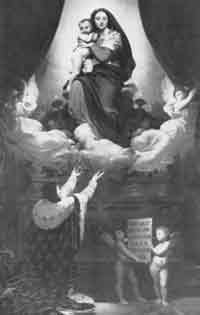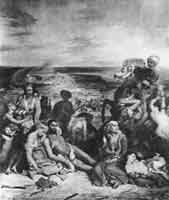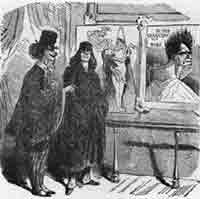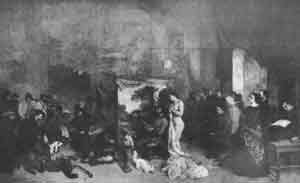The Political Origins of Modernism
sitemap
drawings
paintings 1 2 3 4 5 a b c -
- A B . . . . . . . new
installations
projects
reviews
 |
|||
 |
 |
||
 |
 |
 |
 |
2012
The Political Origins of Modernism
Patricia Mainardi
The Political Origins of Modernism (Part 1)
The question of modernism has traditionally been couched in formal terms addressing issues of flatness, of painterly technique, of reduction of interest in subject matter. Manet is usually considered the first modernist painter, and the origins of the movement placed in the 1860s.[1] I should like to put these formal issues aside for the moment in order to propose another model, what might be called Institutional Modernism. By that I mean the political aspect, the structures by which art is presented to and perceived by its public. By focusing on some events of the 1850s in which the Government of the Second Empire attempted to depoliticize art, I hope to cast some light on the preconditions to our formalist-defined modernism.
Although nineteenth-century art history has usually been interpreted as the conflict between reactionaries and the avant-garde, the principal aesthetic division in France during this period would be more accurately characterized as between the Academy and all other parties. The Academy had been founded in the seventeenth century as a royal agency in charge of aesthetics; opposition to its doctrines would therefore quite naturally be interpreted as double-edged, encompassing both an aesthetic and a political stance. Conservatives never forgot that the Academy had been temporarily suppressed during the Revolution. As a result, they insisted that only a Legitimist monarch would adequately protect Academic interests, and, throughout the century, they attributed the developing aesthetic schism between Academic and anti-Academic to political events.[2]
Romanticism presented the first major challenge to the hegemony of Academic principles. As early as 1800, Mme de Staël announced that the new spirit of Republicanism required a revolution in the character of literature, and, by 1815, the Journal des Débats was proclaiming that Romanticism was nothing other than the extension of the political revolution.[3] Supporters of Romanticism in the visual arts took up this refrain, one critic stating that "society having changed its philosophical and political direction and renounced the majority of its old beliefs, all cultural expressions had to change as well."[4] Romanticism was thus identified by friend and foe alike as the fruit of the Revolution, and, despite the monarchist convictions of many of its early adherents, aesthetic battlelines were gradually drawn along political lines. By the 1820s, it was assumed that liberals would support Romanticism, Constitutional Monarchists might or might not, and only Legitimists would continue to be as committed to classicism as they were to the ancien régime.[5]
Fig. 1. Jean-Auguste-Dominique Ingres, The Vow of Louis XIII, 1824.
The best-known manifestation of the Academic-anti-Academic schism in art was the Ingres-Delacroix rivalry. Although we now define this antithesis in formal terms-as line versus color or Classicism versus Romanticism-it was perceived at the time as also embodying political issues. The Salon of 1824, at which Ingres exhibited his Vow of Louis XIII and Delacroix his Massacre of Scios (Figs. 1 and 2), first saw the articulation of this polarization in terms of Ie beau and Ie laid. the beautiful and the ugly.[6] For if Ie beau was identified with classical academic theory, finding its apotheosis in the work of Ingres, it was also increasingly identified with order, spirituality, and–by its enemies–with the ancien regime.[7] This polarization along political as well as aesthetic lines was catalyzed by the frontal attack on Romanticism emanating from the Académie française on April 24, 1824-the anniversary of the return of the king.[8]"The Salon is as political as the elections," wrote Jal three years later. "The brush and the sketch are the tools of parties as much as the pen. The wishes of the Church and the State are manifested in a dozen pictures or statues."[9]9 As a result, styles themselves soon acquired political content. Even Baudelaire described Ingres's art in political terms redolent of the ancien regime: "cruel," "despotic," and "unresponsive."[10] Ingres's support came from Legitimists, Orleanists, and Clericals, who praised him as a bulwark against change;[11] their espousal of the supposedly eternal values of tradition reflected their own adherence to throne and altar. A cartoon of 1855 (Fig. 3) shows two political reactions to a formal quality, Ingres's color. The gentleman on the left, distinguished by his top hat and goatee, says, "It entrances me," while the man on the right, whose dress and porcine physiognomy are intended to convey his lower-class status, responds, "It leaves me cold."
Fig 2. Eugene Delacroix, Scenes from the Massacre at Scios, 1824.
In contrast, the quality of "ugliness," exemplified by the paintings of Delacroix, seemed tied to anarchy, materialism, and modern life, all seen as consequences of the Revolution. Although suggested by a variety of earlier critics, this reading became established in 1827 when Victor Hugo, in his Preface to Cromwell, proclaimed "ugliness" the standard of Romanticism. "The beautiful has only one type: the ugly has a thousand," he wrote, and went on to claim for "ugliness" the virtues of modernity, variety, dynamism, and humanity.[12] It is not surprising that in an 1830 editorial entitled "De l'anarchie dans les arts," published in the Journal des Artistes et des Amateurs, Charles Farcy simultaneously attacked Hugo and Delacroix and mourned the passing of "the peaceful course of the ancien regime."[13]
Political progressives often stated with approval that Delacroix had overthrown tyranny and established the principle of liberty in art. One critic wrote: "There are very few people nowadays who aren't in one way or another revolutionary; Delacroix is their man."[14] The violence in his paintings seemed to echo the turmoil of his age, and, despite the conservatism of his own politics, he was seen as the representative of intellectuals, of revolution, of anarchy. And so, as a result of the polarization and politicization of aesthetics during this period, while Ingres was being attacked by political progressives as "the ancien regime in art," Delacroix was labeled by conservatives "the far left in painting."[15]
Our modernist lineage in art was first established by conservative nineteenth century critics, who declared that the breakdown of order caused by the 1789 Revolution had produced Delacroix, the "Apostle of Ugliness."[16] He in turn, they claimed, begot his disciple Courbet, who, it was later claimed, begot Manet.
The confrontation of the Academic and the anti-Academic was the main issue, overriding stylistic distinctions; the same moral and political attacks, couched in the same language, were leveled at successive generations who deviated from Academic principles. In the conservative view, the movements of Romanticism, Realism, and Naturalism were all indiscriminately lumped together as the Cult of Ugliness, all opposed to the Academic ideal of Ie beau. Delacroix, Courbet, and Manet were each in turn accused of forsaking beauty for ugliness and, in political terms, all were accused of carrying on the subversive work of undermining both the French state and the French School.
Fig 3. Marcelin, La couleur de monsieur Ingres, Le Journal Pour Rire, 17 November 1855.
Credit must go to E. J. Delécluze in particular for having established the modernist genealogy through his incessant attacks in the conservative Journal des Débats. It was he who had first divided the world of art into Ie beau and Ie laid at the Salon of 1824 and who later accused Delacroix of having introduced "the reign of ugliness" into art.[17] By 1850, without interrupting his attacks on Delacroix, he included Courbet as the newest recruit to the "cult of ugliness" and frankly traced the new naturalism in painting to the heresies introduced by the Romantics.[18] The attacks on Courbet, and Realist painting in general, for depicting "ugliness" are, of course, well known and need no repetition here.[19]
At Manet's first Salon, in 1861, the negative criticism he received linked him immediately both to Courbet and to what was by now a tradition of avant-garde "ugliness.”[20] Such charges were to dog him throughout his career, becoming particularly vicious in 1865 when he exhibited Olympia.[21] He, too, was known as the "Apostle of Ugliness," and, although Baudelaire charged him with being the first artist of decadence, Baudelaire was mistaken, for that honor had previously been awarded to Delacroix.[22] Manet was, in fact, the third.
We today see the radical differences among these three artists. Their contemporaries saw, even more prominently, the gaping chasm that had opened up between Academic principles and, on the other side of the Great Divide, Our Three Heroes. What is it, then, that makes us perceive Manet, the last of this trilogy, as the archetype of modernism? One of the major factors is that he is seen as politically, morally, even emotionally neutral. And yet, it is possible that this neutrality resides, at least in part, in the public rather than in the private perception, that it is something imposed on Manet's art by what I have called Institutional Modernism, as well as a quality inherent in his work. To examine this quality of neutrality in Manet's paintings, it is necessary first to study the moment when a protomodernist reading of art became institutionalized.
By the mid nineteenth century, the Academy, though still in theory the exclusive representative of the French School, was so no longer in fact. It now represented one style among many, although that style, embodied in classical history painting, was still considered the highest category of art. This presented a problem in the organization of the first international art exhibition at the 1855 Universal Exposition in Paris. The government of the Second Empire could stand neither above nor apart from this aesthetic conflict, for political exigencies demanded that it present a strong united front to foreign competition to show that, despite the 1851 coup d'etat that had brought it to power, it did in fact represent all factions. Unlike previous regimes, this one was built on popular support. Since Napoleon III could not ignore any of the various power groups that constituted his electorate, he attempted to appease them all.
Bypassing the Academy, the Imperial Commission announced that each representative of a major style would be given a special retrospective exhibition in which he was to demonstrate his "Progress."[23] That idea was taken over from science and industry and redefined in aesthetic terms as what we would now call "development." Eclecticism, the ability to appreciate each style on its own terms, was declared characteristic of French genius.[24] The artists chosen in this historic venture, besides Ingres and Delacroix, were Horace Vernet and Alexandre Decamps. Even the renegade Courbet was approached, so eager was the government to give the appearance of unanimous support.[25] Courbet refused the invitation but, in setting up his own show, nonetheless borrowed the notion of a retrospective exhibition, for his centerpiece was The Studio: A Real Allegory Defining a Phase of Seven Years of My Artistic Life (Fig. 4).
Fig. 4. Gustave Courbet, The Studio: A Real Allegory Defining a Phase of Seven Years of My Artistic Life, 1855.
Although artists had held such shows earlier, the ideology of the individual retrospective exhibition was an innovation of 1855. It is itself a modernist tool, for it emphasizes the development of an individual self-referential style. In the traditional "School," in contrast, the artist's individuality is subsumed in the interests of shared concerns. This is pointed up by the Academy's unsuccessful counterproposal for the 1855 exhibition; namely, a show to demonstrate the development of the French School in the nineteenth century, which it saw as synonymous with history painting by Academicians.[26] Prince Napoleon described these two contradictory proposals as a show of artists (the eclectic model) and a show of works (the Academic model).[27] The innovation of individual retrospective exhibitions did not meet with popular comprehension; while critics and connoisseurs were enthusiastic about the unprecedented opportunity to study the development of an artist's style, the general public simply did not understand why it should pay to see old paintings. Low attendance plagued both the government's and Courbet's exhibitions, and both were forced to lower their entrance fees.[28]
(Patricia Mainardi; The Political Origins of Modernism, Art Journal, Vol. 45, No.1, Manet, Spring, 1985, p. 11-14.)
The Political Origins of Modernism (Part 2)
Notes:
[1] The most influential exponent of this reading has been Clement Greenberg; see his classic article "Modernist Painting," Art and Literature, 4 (Spring 1965), pp. 193-201.
[2] For a sampling of such opinions, see: Charles Ernest Beulé (secrétaire perpetuel of the Académie des Beaux-Arts from 1862 to 1874), "Du Danger des Expositions," in his Causeries sur L'art, Paris, 1867, pp. 1-39, and Louis Dussieux, L'Art considéré comme Ie symbol de l'État social, Paris, 1838. Leon Rosenthal, Du Romantisme au réalisme, Paris, 1914, gives many examples of the use of 1830 Revolution to mark the decline of art; see pp. 3ff.
[3] Mme de Staël, De la littérature considérée dans ses rapports avec les institutions sociales, ed. Paul van Tieghem, 2 vols., Paris, 1959, see especially, II: pp. 296-317. "H", "Les Scrupules littéraires de Mme la baronne de Staël, ou Réflexions sur quelques chapitres du Livre de l'Allemagne," Journal des Débats, February 8, 1815. René Bray traces the development in his Chronologie du Romantisme (1804- 1830), Paris, 1932.
[4] Auguste Jal, Esquisses, croquis, pochades, ou tout ce qu'on voudra sur Ie Salon de 1827, Paris, 1828, pp. 103-4.
[5] Bray (cited n.3), gives 1823 as the decisive date; see pp. 140-59 for the process by which Romanticism becomes identified with liberal thought.
[6] See: E.J. Delécluze, "Beaux-Arts. 1824," Journal des Débats, September 1, 1824. The terms Ie beau and Ie laid were used by most critics after 1824. Theophile Thoré, "Artistes contemporains. M. Eugene Delacroix," Le Siècle, February 24, 1831, says the Academy called everything laid that wasn't beau, and dates the inception of these "critical categories" at 1824 when the culte du laid was invented as a term of opprobrium for Delacroix.
[7] See, for example: "Y," "Paris. Beaux-Arts. Exposition de 1824," Le Globe, September 17, 1824, where the critic states "on est pour les règles ou pour la barbarie" (one is either for the rules or for barbarism). Some of the most articulate anti-Ingres critics were Alexandre Decamps, Thèophile Thoré, and Laurent-Jan, all in the political as well as aesthetic opposition. See: Decamps, Le Muse, Revue du Salon de 1834, Paris, 1834, pp. 20-26, and "Beaux-Arts. Salon de 1838," Le National, March 5, 1838; Thore, "M. Ingres," La Revue Indépendante III, June 1842, pp. 794-803; Laurent-Jan, "M. Ingres Peintre et Martyr," Le Figaro, December 30, 1855, pp. 2-7 (originally published in the 1840s and reprinted in his Légendes d'Atelier, Paris, 1859); Nadar [Gaspard-Felix Tournachon], "Salon de 1855," Le Figaro, 16, September 23, 1855. Also see: Carol Duncan, "Ingres's Vow of Louis XIII and the Politics of the Restoration," in Henry A. Millon and Linda Nochlin, eds., Art and Architecture in the Service of Politics, Cambridge, Mass., 1978.
[8] See: Stendhal [Henri-Marie Beyle], Racine et Shakespeare No II ou Réponse au manifeste contre Ie Romantisme prononcé par M. Auger dans une séance solennelle de l'Institut, Paris, 1825.
[9] Jal (cited n.4), p. iv.
[10] He does not refer to Ingres by name, but it is clear who is meant; see his "Exposition Universelle. Beaux-Arts. Eugene Delacroix," Le Pays. Journal de ['Empire, June 3, 1855, reprinted in Charles Baudelaire, Écrits sur l'Art, ed. Yves Florenne, 2 vols., Paris, 1971, I: pp.403-4.
[11] See: Charles Blanc, Ingres, sa vie et ses ouvrages, Paris, 1870, pp. 174-75; Henry Lapauze, Ingres, sa vie et son oeuvre, 1780- 1867, Paris, 1911, pp. 465-73; also Duncan (cited n. 7).
[12] On Delacroix, see, for example: E.J. Delécluze, "Exposition du Louvre 1824," Journal des Débats, October 5, 1824, and "Beaux-Arts. Salon de 1827," Journal des Débats, December 20, 1827; Louis Peisse, "Salon de 1831," Le National, May 30, 1831. Victor Hugo, Cromwell, XXII-XXXVI. I am indebted to Charles Rosen and Henri Zerner for their interesting discussion on this question; see their Romanticism and Realism: The Mythology of Nineteenth-Century Art, New York, 1984, pp. 18-19.
[13] Charles Farcy, "De I'anarchie dans les arts," Journal des Artistes et des Amateurs, January 31, 1830, pp.81-83.
[14] Eugène Loudun [Eugène Balleyguier], Le Salon de 1855, Paris, 1855, pp. 13-14; originally published in the Legitimist journal L'Union. For the progressive point of view, see: Auguste Jal, L'Artiste et Ie philosophe. Entretiens critiques sur Ie Salon de 1824, Paris, 1824, pp. 48-53.
[15] On the identification of Ingres and Classicism with the ancien regime, see: Jal (cited n. 4), p. 102; Jal divides art into classique and anticlassique, "faire beau" or "faire laid." On the identification of Delacroix and Romanticism with "I'extrême gauche," see: Delécluze, "Beaux-Arts. Salon de 1827," Journal des Débats, March 21, 1828. For a general discussion of the politicization of art during this period, see: Hugh Honour, Romanticism, New York, 1979, pp. 217-44.
[16] Although the phrase "I'apôtre du laid" was undoubtedly in use earlier, the first recorded instance I have found is in an 1855 letter of Ingres, quoted in Blanc (cited n. 11), p. 183, and Lapauze (cited n. 11), p. 500; also see: Delécluze, Les Beaux-arts dans les deux mondes en 1855, Paris, 1856, p. 214.
[17] Delécluze, "Exposition du Louvre 1824," Journal des Débats, October 5, 1824; and idem (cited n. 11), p. 214. On Delécluze, see: Robert Baschet, E.J. Delécluze, Témoin de son temps, 1781-1863, Paris, 1942.
[18] See: Delécluze, "Exposition de 1850," Journal des Débats, 7, January 21, 1851. A similar opinion was expressed by Louis Peisse, "Salon de 1850," Le Constitutionnel, January 8, 1851.
[19] For a discussion of the issue, see: Emile Bouvier, La Bataille réaliste (1844-1857), Geneva, 1973, pp. 214-57; also see: Timothy J. Clark, Image of the People: Gustave Courbet and the Second French Republic, 1848-1851, Greenwich, Conn., 1973, pp. 137-38; and my "Gustave Courbet's Second Scandal: Les Demoiselles de Village," Arts Magazine 53 (January 1979), pp. 95-109.
[20] See: Hector de Callias, "Salon de 1861," L'Artiste, July 1, 1861, p. 7; Léon Lagrange, "Salon de 1861," Gazette des Beaux-Arts, July 1, 1861, p. 52. For a discussion of the relationship of the two artists, see: Theodore Reff, "Courbet and Manet," Arts Magazine 54 (March 1980), pp. 98-103.
[21] See: Hamilton 1969, pp. 65-80.
[22] Fêlix Jahyer called Manet the "Apostle of Ugliness" in 1865; see: his Etude sur les beaux-arts. Salon de 1865, Paris, 1865, p. 23. Baudelaire wrote to Manet in the same year: "Vous n'êtes que Ie premier dans la décrépitude de votre art"; Baudelaire, Ecrits sur l'art, II, pp. 350-52. The Legitimist Alphonse de Calonne called Delacroix "Un peintre de décadence," in "Exposition Universelle des Beaux-Arts," Revue contemporaine 21 (1855), p. 128. For the context of this charge, see: Koenraad W. Swart, The Sense of Decadence in Nineteenth Century France, The Hague, 1964.
[23] The decision is set forth in a memorandum of the Imperial Commission "Placement définitif" in the Archives Nationales, Paris, F21 519. Prince Napoleon discusses the concept in his Visites et études de S.A.I. Ie Prince Napoléon au Palais des Beaux-Arts, Paris, 1856, pp. 55-56.
[24] The theory was set forth by Théophile Gautier, Les Beaux-Arts en Europe, Paris, 1855, pp. 5-9, and quoted by Prince Napoleon (cited n. 23), p. 59. Both Gautier's and Prince Napoleon's articles were originally published in the Government newspaper Le Moniteur Universel; other critics followed their lead.
[25] Courbet's account of his luncheon with Nieuwerkerke sometime in 1854 describes the Government's efforts to procure his ralliement with a commission for the 1855 Universal Exposition. His letter to Alfred Bruyas is published in "Lettres inédites," L'Olivier, Revue de Nice 8 (September-October 1913), pp. 485-90.
[26] The first proposal was made by the Marquis de Pastoret in 1851, forwarded by the Academy to the Minister of the Interior the same year; see: the Procès-verbaux of March 1, and 8, 1851, Institut de France, Archives de l'Academie des beaux-arts. Pastoret and Prince Napoleon continued to support this plan; see: Paris" Exposition Universelle de 1855, Commission Impériale, Rapport sur l'Exposition Universelle de 1855 présenté à l'Empereur par S.A.l. le prince Napoleon, 1857, p. 13.
[27] "Discours prononcé par S.A.I. Ie Prince Napoléon, Président de la Commission Impériale, à la séance d'inauguration de l'Exposition Universelle, Ie 15 mai 1855," in Rapport (cited n. 26), pp. 399-403.
[28] For the Government's entrance fees, see: Frédéric Bourgeois de Mercey, "L'Exposition Universelle des Beaux-Arts en 1855," Revue contemporaine 31 (1857), pp. 466-94; Mercey was the Commissaire général of the art exhibition. For Courbet's fees, see: Eugène Delacroix, Journal. 1822-1863. ed. André Joubin, Paris, 1980, entry of August 3, 1855.



